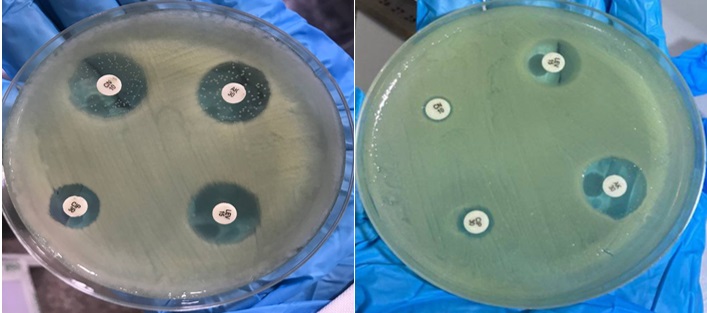The Role of Some Antibiotics on Male and Female Urinary Tract Infections
DOI:
https://doi.org/10.59675/V221Keywords:
Urinary Tract Infection, Bacterial, Antibiotics, Sensitive, Resistance.Abstract
Urinary tract infections (UTIs) are the most common infections that result in discomfort, fever, pain, and infections outside the intestines in people of all age groups. Annually, an estimated 150 million individuals worldwide experience the distressing condition of UTI. Approximately 10% of the global human population experiences a UTI at some point in their lifetime.
Methods: In this study, we analyzed the antimicrobial susceptibility patterns of the commonly isolated Gram-negative and Gram-positive bacteria from urine specimens examined at Imam Hussein Hospital and from a group of students at the College of Pharmacy at Al-Safwa University College in the holy city of Karbala, Iraq. After collecting urine samples, they were cultured in the culture media, and Gram stain was used to study the phenotypic characteristics of isolated bacteria. The types of bacteria causing urinary tract infections were diagnosed. After the diagnosis, antibiotic sensitivity discs were used.
Results: In this study, it was found that women have more urinary tract infections than men, and it was found that (Klebsiella, Escherichia coli, and Enterobacter) bacteria are the most common types of UTI; all types of bacteria discovered in this study are sensitive to the Amikacin antibiotic, on the other hand, all types of bacteria discovered in this study are resistant to the Ciprofloxacin antibiotic.
References
FINER, Gal; LANDAU, Daniel. Pathogenesis of urinary tract infections with normal female anatomy. The Lancet infectious diseases, 2004, 4.10: 631-635. https://doi.org/10.1016/S1473-3099(04)01147-8.
SUBRAMANIAN, Manikandan, et al. Antimicrobial susceptibility pattern of urinary tract infection causing human pathogenic bacteria. Asian J Med Sci, 2011, 3.2: 56-60.: https://www.researchgate.net/publication/265926632.
BARNETT, Ben J.; STEPHENS, David S. Urinary tract infection: an overview. The American journal of the medical sciences, 1997, 314.4: 245-249. https://doi.org/10.1016/S0002-9629(15)40208-3.
ROBINSON, Joan L., et al. Urinary tract infection in infants and children: Diagnosis and management. Paediatrics & child health, 2014, 19.6: 315-319. https://doi.org/10.1093/pch/19.6.315.
HAGAN, Erin C., et al. Escherichia coli global gene expression in urine from women with urinary tract infection. PLoS pathogens, 2010, 6.11: e1001187. https://doi.org/10.1371/journal.ppat.1001187.
LLOYD, Amanda L., et al. Genomic islands of uropathogenic Escherichia coli contribute to virulence. Journal of bacteriology, 2009, 191.11: 3469-3481. https://doi.org/10.1128/jb.01717-08.
VOLLMERHAUSEN, Tara L., et al. Population structure and uropathogenic virulence-associated genes of faecal Escherichia coli from healthy young and elderly adults. Journal of medical microbiology, 2011, 60.5: 574-581. https://doi.org/10.1099/jmm.0.027037-0.
NIELSEN, Karen L., et al. Faecal Escherichia coli from patients with E. coli urinary tract infection and healthy controls who have never had a urinary tract infection. Journal of medical microbiology, 2014, 63.4: 582-589. https://doi.org/10.1099/jmm.0.068783-0.
INABO, H. I.; OBANIBI, H. B. T. Antimicrobial susceptibility of some urinary tract clinical isolates to commonly used antibiotics. African Journal of Biotechnology, 2006, 5.5: 487-489. http://www.academicjournals.org/AJB
KOLAWOLE, A. S., et al. Prevalence of urinary tract infections (UTI) among patients attending Dalhatu Araf Specialist Hospital, Lafia, Nasarawa state, Nigeria. International journal of medicine and medical sciences, 2009, 1.5: 163-167. http://www.academicjournals.org/ijmms
RAMIREZ, Maria S.; TOLMASKY, Marcelo E. Amikacin: uses, resistance, and prospects for inhibition. Molecules, 2017, 22.12: 2267. https://doi.org/10.3390/molecules22122267.
MARSOT, Amélie, et al. Amikacin in critically ill patients: a review of population pharmacokinetic studies. Clinical pharmacokinetics, 2017, 56: 127-138. DOI 10.1007/s40262-016-0428-x.
YUAN, Shi-Min. Mycobacterial endocarditis: a comprehensive review. Brazilian Journal of Cardiovascular Surgery, 2015, 30: 93-103. DOI:10.5935/1678-9741.20140113.
TAYMAN, Cuneyt, et al. Quantification of amikacin in bronchial epithelial lining fluid in neonates. Antimicrobial agents and chemotherapy, 2011, 55.9: 3990-3993. https://doi.org/10.1128/aac.00277-11
BARTOLOMÉ-ÁLVAREZ, JOAQUÍN; SOLVES-FERRIZ, VERÓNICA. Increase in methicillin-resistant and ciprofloxacin-susceptible Staphylococcus aureus in osteoarticular, skin and soft tissue infections. Revista Espanola de Quimioterapia: Publicacion Oficial de la Sociedad Espanola de Quimioterapia, 2020, 33.2: 143-144. https://doi.org/10.37201/req/082.2019.
APANGU, Titus, et al. Successful treatment of human plague with oral ciprofloxacin. Emerging infectious diseases, 2017, 23.3: 553. https://doi.org/10.3201%2Feid2303.161212
Thai, T., Salisbury, B. H., & Zito, P. M. (2023). Ciprofloxacin. In StatPearls [Internet]. StatPearls Publishing.
CHAVES, Bruno J.; TADI, Prasanna. Gentamicin. 2020.
NOEL, Gary J. A review of levofloxacin for the treatment of bacterial infections. Clinical Medicine. Therapeutics, 2009, 1: CMT. S28. https://doi.org/10.4137/CMT.S28
Le, J., Briggs, G. G., McKeown, A., & Bustillo, G. (2004). Urinary tract infections during pregnancy. Annals of Pharmacotherapy, 38(10), 1692-1701. https://doi.org/10.1345/aph.1D630
RAKESH, Kumar, et al. Isolation of human pathogenic bacteria causing urinary tract infection and their antimicrobial susceptibility pattern in a tertiary care hospital, Jaipur, India. Int Res J Med Sci, 2014, 2: 6-10. http://www.isca.me/MEDI_SCI/Archive/v2/i6/2.ISCA-IRJMedS-2014-023.pdf
KULKARNI, Sudheendra Ramesh; PEERAPUR, Basavaraj V.; SAILESH, Kumar Sai. Isolation and antibiotic susceptibility pattern of Escherichia coli from urinary tract infections in a tertiary care hospital of North Eastern Karnataka. Journal of natural science, biology, and medicine, 2017, 8.2: 176. https://doi.org/10.4103%2F0976-9668.210012

Downloads
Published
Issue
Section
License
Copyright (c) 2024 Academic International Journal of Veterinary Medicine

This work is licensed under a Creative Commons Attribution 4.0 International License.


